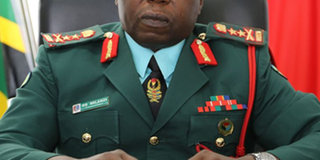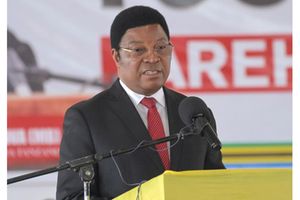Tanzania defends Stiegler’s project in Bahrain talks

Permanent Secretary in the Ministry of Natural Resources and Tourism Major General (rtd) Gaudence Milanzi
What you need to know:
The multi-billion project, which will be generating 2,100 megawatts after the construction of a large dam along the Rufiji River in the Selous Game Reserve, has raised alarm over possible adverse environmental effects.
Dar es Salaam. Tanzania has taken its defence of the Stiegler’s Gorge power project to the United Nations Educational, Scientific and Cultural Organisation (Unesco).
The multi-billion project, which will be generating 2,100 megawatts after the construction of a large dam along the Rufiji River in the Selous Game Reserve, has raised alarm over possible adverse environmental effects.
The development came even as it emerged that the World Heritage Committee had added the Stiegler’s Gorge project as a factor that endangers the Selous ecosystem.
At the 42nd meeting of the World Heritage Committee, currently underway in Bahrain, Tanzania is citing sustainable development to push for the project amid growing pressure to drop it from global conservationists.
A statement released on Thursday by Major General (rtd) Gaudence Milanzi said Tanzania has maintained its position to continue with the project as stated during a meeting of the committee in Poland last year.
“Unesco has agreed to cooperate with Tanzania to ensure the project is environmentally safe,” said Maj Gen wMilanzi, who is the Permanent Secretary in the Ministry of Natural Resources and Tourism.
He is leading nearly a dozen-member delegation in the talks.
The government allocated Sh700 billion in the 2018/19 budget to get the works started. It has also awarded a tender for felling of an estimated three million trees to pave the way for the project. However, while Tanzania insists that an environmental assessment study has already been done on Stiegler’s Gorge, a dispatch from the World Wildlife Fund (WWF) appeared to suggest that the country has embarked on a new study.
The WWF report released on the sidelines of the Bahrain meeting said Tanzania will launch a Strategic Environmental Assessment (SEA) of the proposed $5 billion dam in the world’s game reserve.
“The WWF welcomes the Tanzanian government’s commitment today to initiate the required Strategic Environmental Assessment. This is an important progress, it is imperative that assessment is completed without delay to the highest international standards and is independently reviewed,” said Anthony Field, the Global Campaign Manager at WWF International.
Mr Field added: “The study must also examine alternative, less harmful energy projects that could instead be pursued and cover the ecoregion in its entirety to secure the future of this wilderness site for generations to come.”
He, however, did not mention whether the SEA was different from the study done locally or its relation to the said cooperation with Unesco.
According to him, Tanzania welcomed efforts by partners and countries in the Unesco-protected sites committee to allay fears over the project.
He said the dam was primed to play a critical role in the vision of the government to industrialise the economy.
Other than Unesco, Tanzania also took its defence to International Union for Conservation of Nature (IUCN) and the World Heritage Committee.
He said the country was hailed during these meetings for successfully fighting poaching in the expansive reserve, which is one of the largest in the world.
According the WWF, there were concerns that Tanzania has pushed forward the Stiegler’s Gorge hydropower dam despite concerns over its environmental and social impacts.
He said it was crucial that the SEA be done as stipulated under the Environmental Management Act of 2004.
“The decision by the World Heritage Committee to add the Stiegler’s Gorge hydropower project to the Selous Game Reserve’s In Danger list reflects the proposed dam’s direct threat to the Selous’ globally important wildlife populations and the risks to the livelihoods of more than 200,000 people that live downstream,” said Mr Field in his statement.
“It is critical that no work starts on the project before the SEA has been completed, reviewed and agreed by the World Heritage Centre.”
A World Heritage site since 1982, the Selous Game Reserve is one of Africa’s largest remaining wilderness areas and home to globally significant populations of elephants, black rhinos and wild dogs.
At the meeting, the World Heritage Committee recognised the anti-poaching progress that has been made in Selous, which has potentially stabilized the elephant population and shown that black rhinos are still present in the reserve.
However, the committee agreed that this progress has been overshadowed by the proposal to build the Stiegler’s Gorge dam inside the World Heritage site.
In January this year, Audrey Azoulay, the Director-General of UNESCO, wrote a letter expressing her concern about the irreversible damage the project could have on the Selous. In their reactive monitoring mission report in 2017, IUCN said that the project is ‘fatally flawed’ because of its ecological impact. It called on Tanzania to ‘permanently abandon’ it.
A WWF commissioned analysis, published in July 2017, found that the proposed dam threatens both the Selous Game Reserve World Heritage site and the adjacent Rufiji-Mafia-Kilwa Marine Ramsar site.




